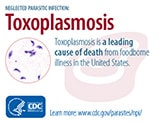Toxoplasmosis: Pregnancy FAQS
On This Page
- When should I be concerned about toxoplasmosis?
- How can Toxoplasma affect my baby?
- How do I know if I have been infected with Toxoplasma?
- How is toxoplasmosis spread?
- Do I have to give up my cat if I’m pregnant or planning on becoming pregnant?
- Is there treatment available for toxoplasmosis?
- What are the best ways to protect myself or my baby against toxoplasmosis?
- Can I breastfeed my baby if I contracted a Toxoplasma infection during pregnancy?
When should I be concerned about toxoplasmosis?
Generally, if you were infected with Toxoplasma before becoming pregnant your baby is protected by your immunity. Some experts suggest waiting for 6 months after a recent infection to become pregnant.
How can Toxoplasma affect my baby?
If you are newly infected with Toxoplasma while you are pregnant, or just before pregnancy, then you can pass the infection on to your baby. You may not have any symptoms from the infection. Most infected infants do not have symptoms at birth but can develop serious symptoms later in life, such as blindness or mental disability. Occasionally, infected newborns have serious eye or brain damage at birth.
How do I know if I have been infected with Toxoplasma?
Your health care provider may suggest one or more varieties of blood tests to check for antibodies to Toxoplasma.
How is toxoplasmosis spread?
Cats play an important role in the spread of toxoplasmosis. They become infected by eating infected rodents, birds, or other small animals. The parasite is then passed in the cat’s feces. Kittens and cats can shed millions of parasites in their feces for as long as 3 weeks after infection. Mature cats are less likely to shed Toxoplasma if they have been previously infected. Cats and kittens prefer litter boxes, garden soils, and sandboxes for elimination, and you may be exposed unintentionally by touching your mouth after changing a litter box, or after gardening without gloves. Fruits and vegetables may have contact with contaminated soil or water also, and you can be infected by eating fruits and vegetables if they are not cooked, washed, or peeled.

Cats play an important role in the spread of toxoplasmosis.
Do I have to give up my cat if I’m pregnant or planning on becoming pregnant?
No. You should follow these helpful tips to reduce your risk of environmental exposure to Toxoplasma:
- Avoid changing cat litter if possible. If no one else can perform the task, wear disposable gloves and wash your hands with soap and water afterwards.
- Ensure that the cat litter box is changed daily. The Toxoplasma parasite does not become infectious until 1 to 5 days after it is shed in a cat’s feces.
- Feed your cat commercial dry or canned food, not raw or undercooked meats.
- Keep cats indoors.
- Avoid stray cats, especially kittens. Do not get a new cat while you are pregnant.
- Keep outdoor sandboxes covered.
- Wear gloves when gardening and during contact with soil or sand because it might be contaminated with cat feces that contain Toxoplasma. Wash hands with soap and water after gardening or contact with soil or sand.
More on: Handwashing
Is there treatment available for toxoplasmosis?
If you are infected during pregnancy, medication is available. You and your baby should be closely monitored during your pregnancy and after your baby is born.
What are the best ways to protect myself or my baby against toxoplasmosis?
Cat owners and women who are exposed to cats should follow these tips to reduce exposure to Toxoplasma.
- Avoid changing cat litter if possible. If no one else can perform the task, wear disposable gloves and wash your hands with soap and water afterwards.
- Ensure that the cat litter box is changed daily. The Toxoplasma parasite does not become infectious until 1 to 5 days after it is shed in a cat’s feces.
- Feed your cat commercial dry or canned food, not raw or undercooked meats.
- Keep cats indoors.
- Avoid stray cats, especially kittens. Do not get a new cat while you are pregnant.
- Keep outdoor sandboxes covered.
- Wear gloves when gardening and during contact with soil or sand because it might be contaminated with cat feces that contain Toxoplasma. Wash hands with soap and water after gardening or contact with soil or sand.
- Wash your hands and safely diaper and feed your baby.
Along with washing your hands, you should also:
- Cook food to an internal temperatures high enough to kill harmful pathogens like Toxoplasma. The only way to tell if food is safely cooked is to use a food thermometer. You can’t tell if food is safely cooked by checking its color and texture (except for seafood).
- Use a food thermometer to ensure foods are cooked to a safe internal temperature. Learn how to place the thermometer correctlyin different food to get an accurate reading.
- Whole cuts of beef, veal, lamb, and pork, including fresh ham: 145°F (then allow the meat to rest for 3 minutes before carving or eating)
- Fish with fins: 145°F or cook until the flesh is opaque and separates easily with a fork
- Ground meats, such as beef and pork: 160°F
- All poultry, including ground chicken and turkey: 165°F
- Leftovers and casseroles: 165°F
- Check this chart for a detailed list of temperatures and foods
- Freeze meat for several days at sub-zero (below 0° F) temperatures before cooking to greatly reduce chance of infection. *Freezing does not reliably kill other parasites that may be found in meat (like certain species of Trichinella) or harmful bacteria.
- Avoid drinking untreated water.
- Do not drink unpasteurized goat’s milk.
- Do not eat raw or undercooked oysters, mussels, or clams (these may be contaminated with Toxoplasma that has washed into seawater).
- For more information on safe food handling to help reduce foodborne illness visit the Food Safety website.
Can I breastfeed my baby if I contracted a Toxoplasma infection during pregnancy?
Yes. Breast milk transmission of Toxoplasma infection is not likely. While Toxoplasma infection has been associated with infants who consumed unpasteurized goat’s milk, there are no studies documenting breast milk transmission of Toxoplasma infection in humans. If a nursing woman were to experience cracked and bleeding nipples or breast inflammation within several weeks following recent Toxoplasma infection (when the organism is still in her bloodstream), it is theoretically possible that she could transmit Toxoplasma to the infant through her breast milk. Immune suppressed women could have Toxoplasma in their bloodstream for longer periods of time. However, the likelihood of human milk transmission is still very small.
External
